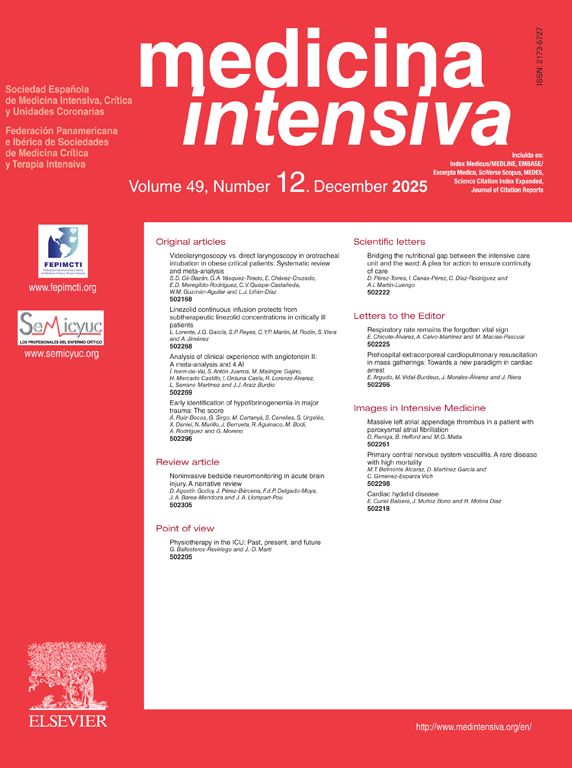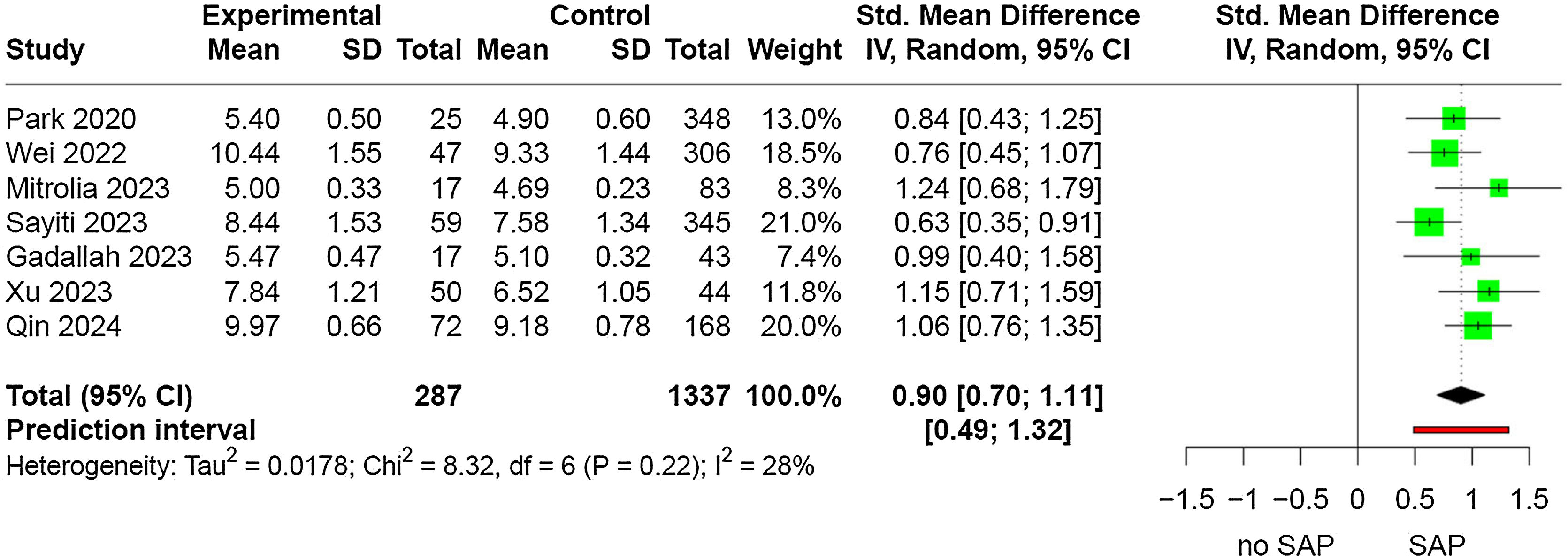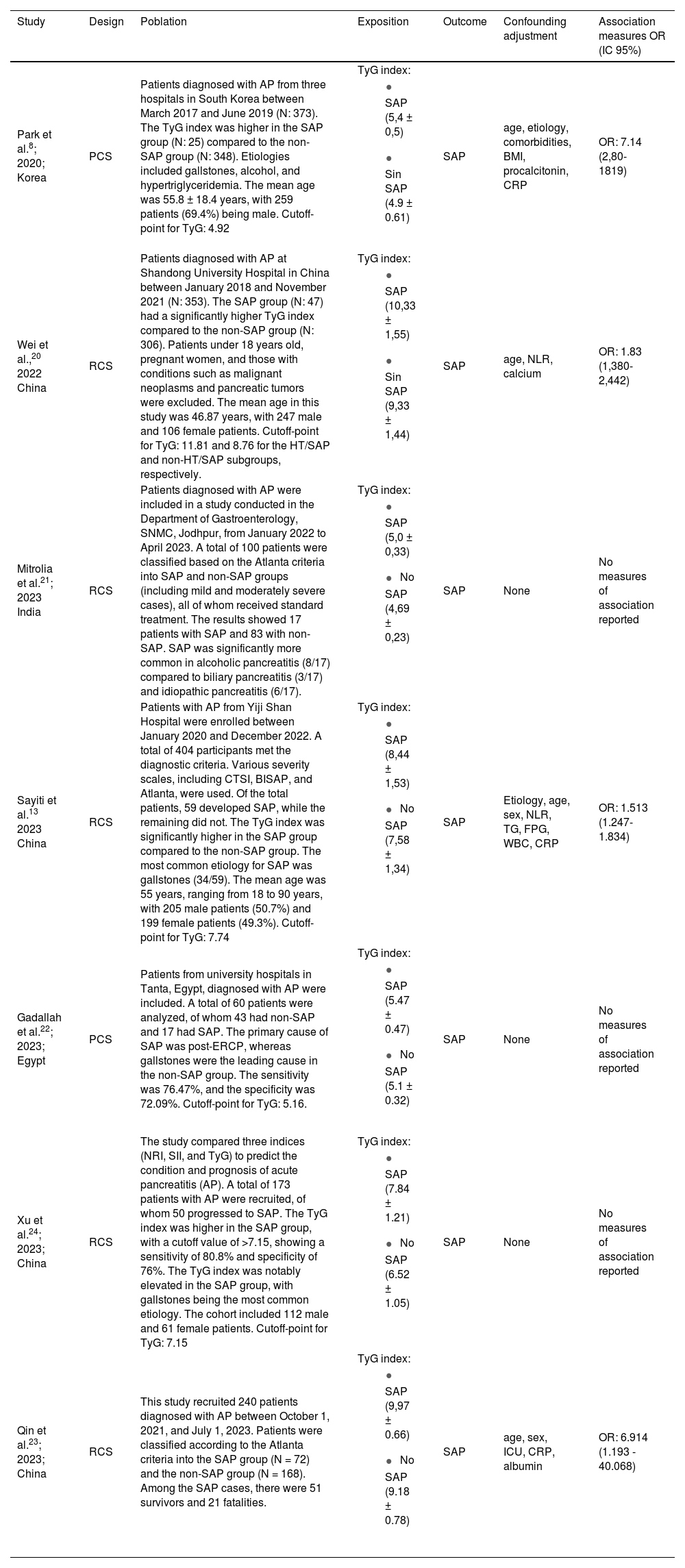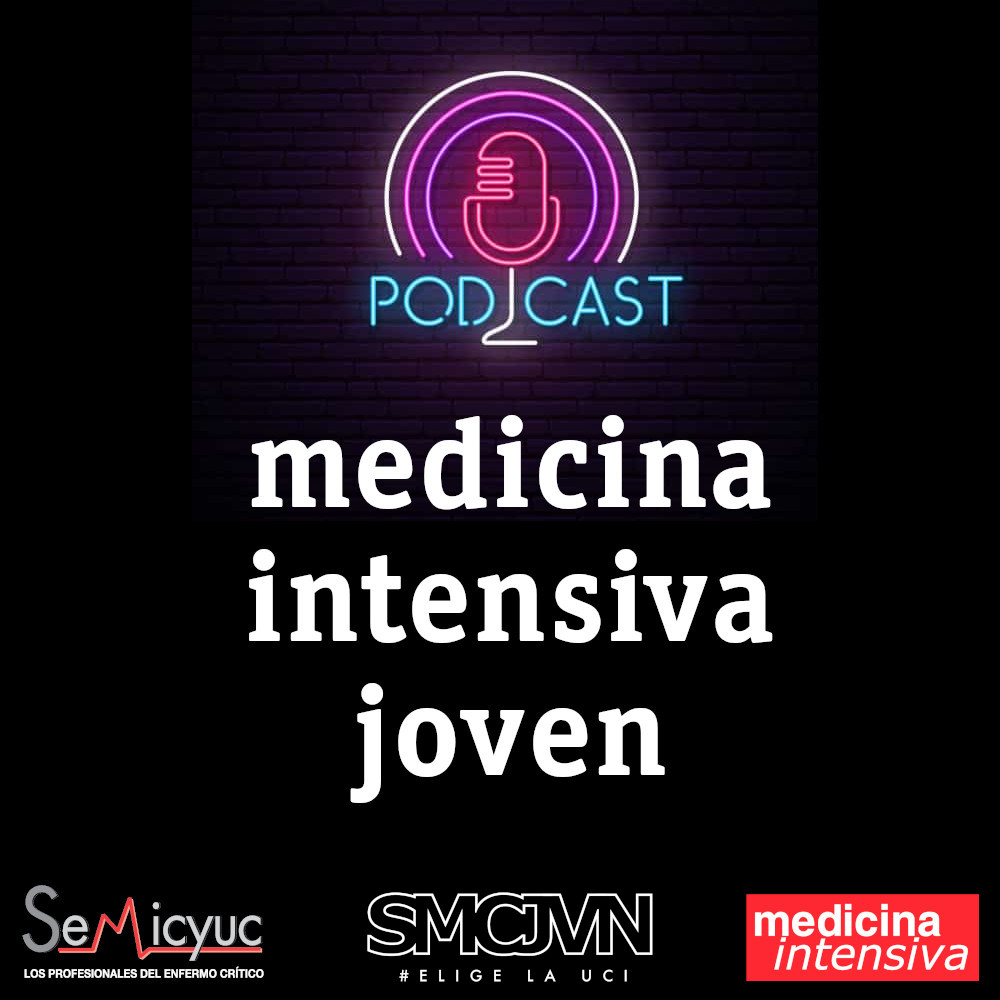The triglyceride-glucose (TyG) index has been proposed as a novel predictive variable of severe acute pancreatitis (SAP)
DesignSystematic review and meta-analysis.
SettingA comprehensive search was conducted across five databases of studies published up to March 17, 2024, using the PECO strategy. Seven studies were identified and included in our meta-analysis.
ParticipantsThe participants of the included primary studies (non-severe acute pancreatitis).
InterventionsHigh triglyceride-glucose (TyG) index
Main variables of interestSevere acute pancreatitis,
ResultsOur analysis evaluated the risk of progression to severity in patients with elevated TyG index in acute pancreatitis through four non-randomized studies. The TyG index was found to be a predictor of severity in acute pancreatitis, with an overall severity risk (OR: 2.38; 95% CI: 1.50–4.08; I²: 80%). Additionally, the analysis of the standardized mean difference (SMD) across all seven studies between patients with SAP and non-SAP yielded an overall mean (OR: 0.90; 95% CI: 0.70–1.11; I²: 28%).
ConclusionIn patients with acute pancreatitis, a TyG index is a predictor of severity.
El índice triglicéridos-glucosa (TyG) ha surgido como un posible marcador predictivo para pancreatitis aguda grave (PAG).
DiseñoEste estudio corresponde a una revisión sistemática y un metaanálisis.
ÁmbitoSe realizó una búsqueda exhaustiva en cinco bases de datos para identificar estudios publicados hasta el 17 de marzo de 2024, utilizando la estrategia PECO. Siete estudios fueron seleccionados e incluidos en el metaanálisis.
ParticipantesPacientes diagnosticados con pancreatitis aguda en estudios primarios, excluyendo aquellos con formas graves de la enfermedad al inicio.
IntervenciónÍndice triglicéridos-glucosa (TyG) elevado.
Variables de interés principalesPancreatitis aguda grave.
ResultadosNuestro análisis evaluó el riesgo de progresión a gravedad en pacientes con un índice TyG elevado mediante cuatro estudios no aleatorizados. El índice TyG se identificó como un predictor de gravedad en la pancreatitis aguda, con un riesgo general de severidad (OR: 2.38; IC 95%: 1.50–4.08; I²: 80%). Además, el análisis de la diferencia de medias estandarizada (SMD) entre los pacientes con PAG y aquellos sin PAG, a través de los siete estudios incluidos, arrojó una media global (OR: 0.90; IC 95%: 0.70–1.11; I²: 28%).
ConclusiónEn pacientes con pancreatitis aguda, el índice TyG es un predictor de gravedad.
Currently, acute pancreatitis (AP) is a common condition with an incidence of approximately 30 per 100,000 men and 20 per 100,000 women in Western countries.1 Global mortality is approximately 5%, but it can reach up to 35% in complicated necrotizing forms.2,3
To assess the severity of AP, several scoring systems have been developed to facilitate rapid and timely intervention. Among these, Ranson et al. introduced the first scoring system in 1974, which predicts disease severity based on eleven parameters obtained at admission or within 48 hours. The Ranson score has a low positive predictive value of approximately 50% but a high negative predictive value of around 90%.4–6 The severity of AP can also be evaluated using the Acute Physiology and Chronic Health Evaluation (APACHE II) score, which has a positive predictive value of 43% and a negative predictive value of 89%. Other commonly used tools include the BISAP scale and imaging-based tools such as the Balthazar Score. All these methods aim to predict disease severity.7
Additionally, some prognostic scores incorporate metabolic parameters such as blood glucose levels, given their role as indicators of metabolic disturbances characteristic of severe AP. Other relevant factors include triglyceride levels, vitamin D deficiency, and serum apolipoprotein B-to-A-I ratio abnormalities, all of which are closely associated with the severity and prognosis of AP.8
The triglyceride-glucose (TyG) index is a novel surrogate marker for insulin resistance and metabolic abnormalities. Its role is supported by studies showing that triglycerides in skeletal muscle are inversely related to insulin sensitivity in skeletal muscle and whole-body insulin action. The TyG index has been reported to predict diabetes mellitus, hypertension, nonalcoholic fatty liver disease (NAFLD), and cardiovascular disorders. However, little is known about the association between the TyG index and AP severity.9
The objective of this Systematic Review and Meta-Analysis (SR-MA) is to integrate existing studies evaluating the role of the TyG index as a predictor of severity in severe AP (SAP). To our knowledge, this is the first secondary study to assess this association for this purpose.
MethodsSearch strategyOur systematic review adheres to the methodological standards outlined in the Cochrane Handbook for Systematic Reviews of Interventions10 and PRISMA guidelines.11 The study protocol was registered in PROSPERO (CRD42024543269) prior to implementation. A comprehensive search was conducted in major databases, including Medline (via PubMed), Web of Science (WoS), Scopus, Embase, and Science Direct. Our search strategy utilized controlled vocabulary (MeSH terms) and free-text terms combined with Boolean operators to address our PECOS research question: Population (adults with acute pancreatitis), Exposure (elevated TyG index), Comparator (normal TyG index), Outcome (progression to severe acute pancreatitis), and Study type (observational studies). Keywords were carefully selected to encompass relevant exposures (triglyceride and glucose index) and the primary outcome (“acute pancreatitis” OR “severe acute pancreatitis”). Further details on the search strategy are provided in the Supplementary material (Table 1S).
All articles identified during the primary and secondary searches were compiled using Zotero® 6.0.15. After duplicate removal, manuscripts were transferred to Rayyan, where two authors (GAVT and OYAV) independently and blinded reviewed the titles and abstracts. Articles selected by both authors were included, and discrepancies were resolved by a third author (EDMR) through an additional review. The selected articles underwent a full-text review to determine their eligibility. The selection process is detailed in Fig. 1.
Selection CriteriaObservational studies (prospective or retrospective cohorts, case-control, and cross-sectional studies) were included, as well as studies involving adult patients of both sexes diagnosed with acute pancreatitis, regardless of etiology, publication date, or language. These studies had to include TyG index as a variable for evaluating severity. Excluded studies included case reports or case series, abstracts, letters to the editor, duplicate studies across two or more databases, and studies involving pediatric patients. The TyG index was calculated in all included articles as: Ln [fasting TG (mg/dL) × fasting plasma glucose (mg/dL)] / 2.8,12
OutcomeThe primary outcome assessed was the progression to SAP in patients initially admitted with AP. All selected studies used the severity definition from the Atlanta 2012 criteria. Severity was defined as the persistence of organ failure beyond 48 hours.3,8,13
Data ExtractionTwo researchers collected and extracted relevant information from each study using an Excel spreadsheet. Extracted data included author, country, year, population characteristics, exposure, hospital and ICU stay, TyG values, measures of association, confounding variables, and outcomes. For dichotomous variables, odds ratios (OR) with 95% confidence intervals (CI) were recorded based on events in exposed and unexposed groups. For continuous variables, data were recorded as mean and standard deviation (SD) for exposed and unexposed groups or as mean and interquartile range (IQR).14
Statistical AnalysisWe utilized the Inverse Variance (IV)15 method in the meta-analysis to combine adjusted odds ratios (ORs) and their corresponding 95% confidence intervals (CIs). The analysis was conducted using R® version 4.2.2 software, leveraging the meta library. Forest plots were generated to summarize the quantitative synthesis, employing the metabin16 function for dichotomous variables and the metacont17 function for continuous variables. The IV method with the DerSimonian-Laird (DL) approach for tau² estimation was applied.
Heterogeneity among studies was assessed using Cochran’s Q test and Higgins’ I² statistic. When substantial heterogeneity was detected (I² > 40%), a random-effects model without Hartung-Knapp (HK) adjustment was applied. To further explore heterogeneity, we performed a sensitivity analysis using the InfluenceAnalysis function and the Graphic Display of Heterogeneity (GOSH)18 through the gosh.diagnostics function.
Quality AssessmentEach study was individually assessed for risk of bias. The risk of bias in the primary studies was evaluated using the Newcastle-Ottawa Scale (NOS) tool.19
ResultadosSearch results and study characteristicsThe search was conducted in databases (Medline via PubMed, Scopus, Embase, WoS, and Science Direct) using an advanced search strategy, yielding a total of 66 articles. Twenty duplicates were removed, leaving 46 articles for screening. Titles and abstracts were reviewed, and 35 articles were excluded, resulting in 11 articles selected for full-text review. During this process, four additional articles were excluded—three due to incomplete data and one for having a different study design. Ultimately, 7 studies were included in the systematic review8,13,20–24 (Fig. 1), comprising 5 retrospective cohort studies and two prospective cohort studies.
A total of 1,624 patients with AP were included in this meta-analysis, of whom 18% (176 patients) progressed to SAP. The primary studies analyzed were conducted in Asia and Africa, specifically in countries such as Korea,8 China,13,20,23,24 India,21 and Egypt.22 The mean age across all studies and patient groups who developed SAP exceeded 50 years. The main etiology of AP was gallstones, followed by hypertriglyceridemia, and lastly, alcohol-related causes (Table 1).
General characteristics of included studies.
| Study | Design | Poblation | Exposition | Outcome | Confounding adjustment | Association measures OR (IC 95%) |
|---|---|---|---|---|---|---|
| Park et al.8; 2020; Korea | PCS | Patients diagnosed with AP from three hospitals in South Korea between March 2017 and June 2019 (N: 373). The TyG index was higher in the SAP group (N: 25) compared to the non-SAP group (N: 348). Etiologies included gallstones, alcohol, and hypertriglyceridemia. The mean age was 55.8 ± 18.4 years, with 259 patients (69.4%) being male. Cutoff-point for TyG: 4.92 | TyG index: | SAP | age, etiology, comorbidities, BMI, procalcitonin, CRP | OR: 7.14 (2,80- 1819) |
| ||||||
| Wei et al.,20 2022 China | RCS | Patients diagnosed with AP at Shandong University Hospital in China between January 2018 and November 2021 (N: 353). The SAP group (N: 47) had a significantly higher TyG index compared to the non-SAP group (N: 306). Patients under 18 years old, pregnant women, and those with conditions such as malignant neoplasms and pancreatic tumors were excluded. The mean age in this study was 46.87 years, with 247 male and 106 female patients. Cutoff-point for TyG: 11.81 and 8.76 for the HT/SAP and non-HT/SAP subgroups, respectively. | TyG index: | SAP | age, NLR, calcium | OR: 1.83 (1,380-2,442) |
| ||||||
| Mitrolia et al.21; 2023 India | RCS | Patients diagnosed with AP were included in a study conducted in the Department of Gastroenterology, SNMC, Jodhpur, from January 2022 to April 2023. A total of 100 patients were classified based on the Atlanta criteria into SAP and non-SAP groups (including mild and moderately severe cases), all of whom received standard treatment. The results showed 17 patients with SAP and 83 with non-SAP. SAP was significantly more common in alcoholic pancreatitis (8/17) compared to biliary pancreatitis (3/17) and idiopathic pancreatitis (6/17). | TyG index: | SAP | None | No measures of association reported |
| ||||||
| Sayiti et al.13 2023 China | RCS | Patients with AP from Yiji Shan Hospital were enrolled between January 2020 and December 2022. A total of 404 participants met the diagnostic criteria. Various severity scales, including CTSI, BISAP, and Atlanta, were used. Of the total patients, 59 developed SAP, while the remaining did not. The TyG index was significantly higher in the SAP group compared to the non-SAP group. The most common etiology for SAP was gallstones (34/59). The mean age was 55 years, ranging from 18 to 90 years, with 205 male patients (50.7%) and 199 female patients (49.3%). Cutoff-point for TyG: 7.74 | TyG index: | SAP | Etiology, age, sex, NLR, TG, FPG, WBC, CRP | OR: 1.513 (1.247-1.834) |
| ||||||
| Gadallah et al.22; 2023; Egypt | PCS | Patients from university hospitals in Tanta, Egypt, diagnosed with AP were included. A total of 60 patients were analyzed, of whom 43 had non-SAP and 17 had SAP. The primary cause of SAP was post-ERCP, whereas gallstones were the leading cause in the non-SAP group. The sensitivity was 76.47%, and the specificity was 72.09%. Cutoff-point for TyG: 5.16. | TyG index: | SAP | None | No measures of association reported |
| ||||||
| Xu et al.24; 2023; China | RCS | The study compared three indices (NRI, SII, and TyG) to predict the condition and prognosis of acute pancreatitis (AP). A total of 173 patients with AP were recruited, of whom 50 progressed to SAP. The TyG index was higher in the SAP group, with a cutoff value of >7.15, showing a sensitivity of 80.8% and specificity of 76%. The TyG index was notably elevated in the SAP group, with gallstones being the most common etiology. The cohort included 112 male and 61 female patients. Cutoff-point for TyG: 7.15 | TyG index: | SAP | None | No measures of association reported |
| ||||||
| Qin et al.23; 2023; China | RCS | This study recruited 240 patients diagnosed with AP between October 1, 2021, and July 1, 2023. Patients were classified according to the Atlanta criteria into the SAP group (N = 72) and the non-SAP group (N = 168). Among the SAP cases, there were 51 survivors and 21 fatalities. | TyG index: | SAP | age, sex, ICU, CRP, albumin | OR: 6.914 (1.193 - 40.068) |
|
PCS: Prospective cohort study; RCS: Retrospective cohort study; AP: acute pancreatitis; SAP: severe acute pancreatitis; TyG index: Triglycerid-Glucose Index; NRI: Nutritional risk indexl; SII: sistemic immflamation inmune; BMI: body mass index; CPR:vC-reactive protein; NLR: Neutrophil-to-Lymphocyte Ratio; TG: triglyceride; FPG: fast plasmatic glucose; WBC: White blood count; ICU: Intensive care unit; HT: Hypertriglyceridemia.
The risk of bias was assessed using the Newcastle-Ottawa Scale (NOS),19 which evaluates the validity and quality of observational studies, particularly non-randomized studies (NRS). All 7 studies demonstrated a low risk of bias, indicating high methodological quality in terms of selection, adjustment for confounding variables, and reliable outcomes (Table 2).
NOS for risk of bias and quality assessment of non-randomized studies (NRS).
| Author | Year | Selection | Comparability | Outcome | Total | Conclusion |
|---|---|---|---|---|---|---|
| Park et al. (9) | 2020 | ⋆⋆⋆⋆ | ⋆⋆ | ⋆⋆⋆ | 9 | Low risk |
| Wei et al. (11) | 2022 | ⋆⋆⋆⋆ | ⋆⋆ | ⋆⋆⋆ | 9 | Low risk |
| Mitrolia et al. (12) | 2023 | ⋆⋆⋆⋆ | ⋆ | ⋆⋆⋆ | 8 | Low risk |
| Sayiti N et al. (25) | 2023 | ⋆⋆⋆⋆ | ⋆⋆ | ⋆⋆⋆ | 9 | Low risk |
| Gadallah et al. (13) | 2023 | ⋆⋆⋆⋆ | ⋆ | ⋆⋆⋆ | 8 | Low risk |
| Xu et al. (26) | 2023 | ⋆⋆⋆⋆ | ⋆ | ⋆⋆⋆ | 8 | Low risk |
| Qin X et al. (27) | 2024 | ⋆⋆⋆⋆ | ⋆⋆ | ⋆⋆⋆ | 9 | Low risk |
NOS, Newcastle-Ottawa scale; NRS, non-randomized study.
Of the seven studies included in the meta-analysis, only four8,13,20,23 reported the TyG index with measures of association (OR and 95% CI) for SAP. The meta-analysis of these studies revealed a 48% increased risk of developing SAP in patients with elevated TyG (OR 2.48; 95% CI 1.50–4.08; I² = 80%) (Fig. 2). Due to the high heterogeneity, a sensitivity analysis was conducted using InfluenceAnalysis, which identified Park et al.8 as an outlier. After excluding this study, the analysis showed a consistent association between elevated TyG index and SAP risk, with moderate heterogeneity (OR 1.83; 95% CI 1.27–2.65; I² = 67%) (Fig. 3).
TyG as a numerical variable (effect size) in patients with SAP and non-SAPWhen TyG was analyzed as a numerical variable ((8,13,20–24), higher mean values were consistently observed in the SAP group compared to the non-SAP group. The meta-analysis demonstrated that the effect size of TyG values, expressed as the standardized mean difference (SMD) between the non-SAP and SAP groups, was 0.90 (95% CI: 0.70–1.11; I² = 28%), highlighting a significant and substantial difference between the two groups (Fig. 4).
DiscussionTyG index as a predictor of progression to SAPOur analysis of the seven primary studies included in this meta-analysis demonstrates that the TyG index is a significant predictor of progression to SAP (OR 2.48; 95% CI 1.50–4.08; I² = 80%). Patients with SAP showed higher mean TyG index values compared to those who did not progress to greater severity, highlighting its potential as an early risk predictor. This finding supports the integration of the TyG index into traditional severity prediction models for SAP, regardless of etiology.
Currently, there are no previous SR-Ms to compare with our findings. However, the role of the TyG index has been implicated and demonstrated in various diseases beyond AP, including diabetes, hypertension, NAFLD, and cardiovascular events. The TyG index is primarily considered a surrogate marker of insulin resistance (IR) and metabolic abnormalities, given that IR is associated with both hyperglycemia and hypertriglyceridemia.25,26
In the context of AP, peripancreatic fat inflammation plays a crucial role in its pathophysiology. Metabolic disturbances linked to IR, such as hyperglycemia and hypertriglyceridemia, can exacerbate both immune and non-immune responses, contributing to the onset or worsening of SAP severity.27 Specifically, hypertriglyceridemia has been identified as a critical factor in the progression to more severe disease forms. Elevated triglycerides may be hydrolyzed into free fatty acids by pancreatic lipases in damaged tissues, inhibiting mitochondrial function in pancreatic acinar cells. This cascade results in elevated intracellular calcium, inflammatory cytokine release, and tissue injury, clinically manifesting as organ damage or SAP.25–27
Observational studies like a Park et al.8 enrolled 373 patients from three hospitals and found that the TyG index was significantly higher in those who developed SAP, with a 48% increased risk of progression (OR 2.48; 95% CI 2.80–18.19). Additionally, the study showed that incorporating the TyG index into predictive models improved the area under the curve (AUC) from 0.74 to 0.83 when combined with clinical and laboratory variables such as CRP, procalcitonin, age, sex, comorbidities (e.g., diabetes), BMI, and etiology.
On the other hand, Wei et al.20 studied 353 AP patients in Shanghai, categorizing them by severity. After adjusting for confounders in a multivariate logistic regression analysis, the TyG index was an independent predictor of progression to SAP (OR 1.83; 95% CI 1.38–2.44; p < 0.001). The study also evaluated the TyG index by etiology (hypertriglyceridemia [HTG] vs. non-HTG), demonstrating its predictive value in both groups.
Moreover, Lee et al.28 examined 313 patients and found that those with a higher TyG index were more likely to require ICU admission and had prolonged hospital stays. The analysis reported an OR of 2.59 (95% CI 1.27–5.30) for predicting SAP and an AUC of 0.731, emphasizing its predictive utility.
Although there are other severity prediction scores, such as PANC3,3 BISAP (Bedside Index for Severity in Acute Pancreatitis), the Ranson score, and the Computed Tomography Severity Index (CTSI), comparisons with TyG have only been attempted in primary studies. Park et al.8 evaluated the AUC of these scores and found that BISAP outperformed both the Ranson score and TyG, with AUCs of 0.82, 0.79, and 0.79, respectively. Similarly, Sayiti et al.13 compared their predictive performance for SAP and reported that BISAP (AUC 0.82) was superior to CTSI and TyG, which had AUCs of 0.78 and 0.65, respectively. While both BISAP and CTSI are reliable severity scores, CTSI is an imaging-based score and therefore not an early predictor. In contrast, BISAP, as a clinical score, can be applied within the first 24 hours, similar to TyG. Although TyG has been evaluated in only a few studies, it has shown promising results, is easy to calculate, and may be considered a biomarker based on triglycerides and fasting glucose.
Clinical applicability of the TyG indexThe TyG index offers notable advantages for clinical practice due to its accessibility and ease of calculation. Unlike other severity assessment systems such as APACHE II, BISAP, or Ranson scores, which require multiple physiological and biochemical parameters, the TyG index relies solely on fasting triglyceride and glucose levels. This simplicity makes it a particularly valuable tool in resource-limited settings, allowing clinicians to quickly and effectively identify high-risk patients and tailor their management strategies accordingly.3,6,8
The evidence presented in this study suggests that the TyG index could be integrated as an early and accessible marker for managing AP, aiding not only in severity prediction but also in optimizing hospital resource allocation and treatment planning.
Therefore, we believe that stratifying at-risk patients using the TyG index will enable a more targeted treatment approach for those at higher risk of severe disease progression. However, further research is needed to determine the optimal cutoff point for its application across different populations and assess whether the etiology of pancreatitis influences these thresholds. Additionally, it is essential to compare the TyG index with other validated scores or predictors and evaluate its potential as a prognostic marker for hospitalization and mortality.
Strengths and limitationsOur study has several strengths. First, we employed a comprehensive search strategy across six major databases and clinical trial registries. Second, we implemented a robust methodology, including a thorough quality assessment and statistical analyses addressing heterogeneity. Third, our findings provide robust data supporting the role of the TyG index as a predictor of SAP, with consistent results across individual studies that employed rigorous statistical evaluations, controlled for confounders, and used uniform definitions for calculating the TyG index.
However, some limitations must be acknowledged. First, when assessing the strength of association using ORs, we observed high heterogeneity due to the inclusion of all AP patients without stratifying by etiology or uniformly controlling for confounders. Second, most studies were conducted in Asia, necessitating further research in diverse populations to enhance generalizability across different ethnicities and geographic regions.
ConclusionsOur SR-Ms demonstrates that an increase in the TyG index is associated with a 48% higher risk of developing SAP. For this reason, the TyG index can be used as a novel predictor and incorporated into the enhancement of other clinical and/or laboratory predictive scores to improve their performance.
CRediT authorship contribution statementGV-T: Conceptualization, Data curation, Formal analysis, Funding acquisition,
Investigation, Methodology, Project administration, Resources, Software, Supervision,
Validation, Visualization, Writing – original draft, Writing – review & editing.
OA-V: Conceptualization, Data curation, Formal analysis, Funding acquisition,
Investigation, Methodology, Project administration, Resources, Software, Supervision,
Validation, Visualization, Writing – original draft, Writing – review & editing.
EM-R: Conceptualization, Formal analysis, Methodology, Project administration, Writing – original draft. MC-C: Validation, Visualization, Writing – review & editing.
CQ-C: Methodology, Writing – original draft.
WG-A: Writing – original draft, Funding
LL-D: Writing – original draft, Funding
Declaration of Generative AI and AI-assisted technologies in the writing processThe authors declare that no form of AI has been used in the preparation of this manuscript.
Funding StatementThe authors confirm that no financial support was received for the research, authorship, or publication of this article.
Publisher's NoteThe views and opinions expressed in this article are solely those of the authors and do not necessarily reflect those of their affiliated institutions, the publisher, editors, or reviewers. The publisher does not endorse or guarantee the accuracy of any product evaluations or claims made by manufacturers mentioned in this article.
Data Availability StatementAll data supporting the findings of this study are provided within the article and its supplementary material. For additional information or specific inquiries, please contact the corresponding author.















